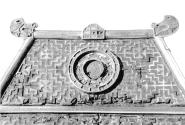Advanced Search
Reliquary casket ("Emly Shrine")
Irish
Early medieval
late 7th–early 8th century
Place of Manufacture: Ireland
Medium/Technique
Champlevé enamel on bronze over yew wood; gilt bronze moldings, inlay of lead-tin alloy
Dimensions
9.2 x 4.1 x 10.5 cm (3 5/8 x 1 5/8 x 4 1/8 in.)
Credit Line
Theodora Wilbour Fund in memory of Charlotte Beebe Wilbour
Accession Number52.1396
CollectionsEurope
ClassificationsEnamels
Made to hold the sacred relics of a saint (often parts of the saint’s body), Irish house-shaped reliquaries have been discovered as far away as Norway and Italy—carried there by Irish pilgrims or Viking raiders. This one, however, was found in Ireland and is named for its nineteenth century owner, Lord Emly of Limerick. It is quite tiny and was probably hung from the neck or shoulder of its owner as a source of protection and spiritual strength.
DescriptionCarved from a single block of wood, the body and lid have bronze moldings applied with small nails on the edges. Attached to the ridgepole of the sloped roof are bird's-head terminals in green, yellow and red (now brown) enamel and a central boss-repeating the shape of the shrine- with a grid of yellow and green enamel. Only the front is decorated with thin strips of a lead-tin alloy hammered into a repetitive step pattern around central crosses engraved in the wood and with three medallions with yellow and green enamel arranged in a geometric pattern of concentric circles. There are two hinges on the back and an interior clasp on the front.
ProvenanceBy 1853, William Monsell (b. 1812 - d. 1894), 1st Baron Emly of Tervoe, Limerick County, Ireland [see note 1]; until 1952, by descent within the family; 1952, sold by Lord Emly (probably Edmond Alan Tremeur de Poher de la Poer-Monsell) to the MFA for $22,874. (Accession Date: October 9, 1952)
NOTES:
[1] It was in his possession by 1853, when he lent it to the Royal Irish Academy, Dublin.
NOTES:
[1] It was in his possession by 1853, when he lent it to the Royal Irish Academy, Dublin.





